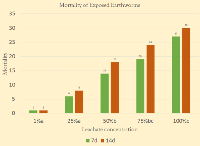Assessment of The Toxicity of Leachate from Municipal Waste Dump Site to Earthworm - Lumbricus terrestris
Keywords:
Lumbricus terrestris, oxidative stress, dumpsite leachate, toxicity, antioxidantAbstract
The study characterized leachate from a refuse dump site in Aba, Abia State, Nigeria and assessed its toxicity to Lumbricus terrestris. Leachate samples were collected, and the physiochemical properties determined using portable equipment and standard analytical
procedures. Ten earth worms with mean weight of 0.23±0.11g and length of 6.92±1.88 cm was exposed for 14 days to 500g of sieved soil spiked with 1%, 25%, 50%, 75% and 100% leachate concentration in triplicates. Mortality was assessed on day 7 and 14 while antioxidant activities were assessed on day 14. The results showed that electrical conductivity (360.333±346.634µs/cm), total dissolved solids (28.00±1.00mg/l), arsenic (0.34±0.03mg/l), nickel (0.13±0.03mg/l), cadmium (0.09±0.03 mg/l), lead (0.45±0.01mg/l), biochemical oxygen demand (32.33±3.06mg/l), chemical oxygen demand (129±3.61mg/l), total organic carbon (156.87±116.11mg/l), nitrate (34.00±0.87mg/l), phosphate, (25.80±3.75mg/l), and sulphate (360±43.41mg/l) were above the FEPA 1991 standard. The 7 day and 14 day LC50 was 60.04 (52.56-68.34) % and 52.90 (46.85-58.85) % respectively. Glutathione (17.85±2.54µm/l) and catalase activity (14.87±0.47µm/l) decreased significantly (p<0.05) in earthworms exposed to 75 and 100% leachate compared to earthworms exposed to 1, 25 and 50% leachate concentration and the control, while super oxide dismutase activity increased and decreased significantly in earthworms exposed to 1% and 100% concentrations respectively compared to the control. Malondialdehyde increased significantly in earthworms exposed to 50%, 75% and 100% leachate compared to the control and earthworms exposed to 1%, 25% leachate
concentration. The study showed that dumpsite leachate contained hazardous substances and was deleterious to L. terrestris.
Downloads
References
Adhikari B., Dahal K.R, and Khanal S.N. (2014). A Review of Factors Affecting the Composition of Municipal Solid Waste Landfill Leachate. International Journal of Engineering Science and Innovative Technology. 3:273-281.
Aebi, H.E (1983). Catalase. In Methods of Enzymatic Analysis, 3rd ed.; Bergmeyer, H.U., Ed.; Verlag Chemie: Weinheim, FL, USA; 273–286.
Akujieze, C.N., and Idehai, I.M. (2014). Physiochemical assessment of landfill generated leachates in lagos, nigeria. International Journal of Science and Engineering, 7(2), 113-123.
Asibor G., Edjere O., and Ebighe D. (2016). Leachate Characterization and assessment of surface and groundwater qualities near municipal solid waste dump site at Okuvo, Delta State, Nigeria. Ethiopian Journal of Environmental Studies and Management 9(4): 523-533
Bengtsson, G., Ek, H., and Rundgren S. (1992). Evolutionary response of earthworms to long term metal exposure. Oikos; 63:289-297.
Calabrese E.J., and Baldwin, L.A (2002). Defining Hormesis. Hum Exp Toxicol 21: 91-97
Egun N.K., Iniaghe O.P., Evbayiro O.J (2016). Assessment of landfill sites for solid waste management in Delta state, Nigeria J. Environ. Waste Manag; 3(1): 116-122
Ercal N., Gurer-Orhan H. and Aykin-Burns N. (2001). Toxic Metals and Oxidative Stress Part I: Mechanisms Involved in Metal induced Oxidative Damage, Curr Top Med Chem, 1(6): 529-539.
Federal Environmental Protection Agency (FEPA) (1991). National Interim Guidelines and Standards for Industrial Effluents and Water
Quality Tests. FEPA: 246.
Fridovich, I. (1989). Superoxide radical: an endogenous toxicant. Annu. Rev. Pharmacol. Toxicol., 23: 239–257.
Fründ, H., Ulfert G., and Sabine, T. (2010). Earthworms as Bioindicators of Soil Quality. 261-278. 10.1007/978-3-642-14636-7_16.
Jaishankar, M., Tseten, T., Anbalagan, N., Mathew, B.B., and Beeregowda, K.N (2014). Toxicity, mechanism and health effects of some heavy metals. Interdiscip Toxicol, 7(2): 60–72. http://doi.org/10.2478/intox-2014-0009
Jollow, D.J., Michell, J.R., Zampaglione, N., and Gillete, J.R (1974). Bromo benzene induced Liver necrosis: Protective role of glutathione and evidence for 3, 4-Bromobenzene oxide as hepatotoxic metabolite. Pharmacology 11, 151–169.
Nunes Júnior, F.H., Gondim, F.A., Pereira, M., Braga, B.B., Pontes Filho, R.A., and Barbosa, F.E. L. (2016). Sanitary landfill leachate as a source of nutrients on the initial growth of sunflower plants. Rev. bras. eng. agríc. ambient, 20(8): 746-750.
Kjeldsen, P., Barlaz M.A., Rooker A.P., Baun A., Ledin A., and Christensen T.H (2002). Present and Long-Term Composition of MSW Landfill Leachate: A Review, Crit Rev Environ Sci Technol., 32(4): 297-336.
Lemtiri, A., Colinet, G., Alabi, T., Cluzeau, D., Zirbes, L., Haubruge, E., and Francis, F. (2014). Impacts of earthworms on soil components and dynamics. A review. Biotechnol. Agron. Soc. Environ. 18(1): 121-133
Magwere T., Naik Y.S., and Hasler J.A. (1997). Effect of chloroquine treatment on antioxidant enzymes in rat liver and kidney. Free Radic. Biol. Med. 22: 321–327.
Maity, S., Banerjee, R., Goswami, P., Chakrabarti M., and Mukherjee A. (2018). Oxidative stress responses of two different ecophysiological
species of earthworms (Eutyphoeus waltoni and Eisenia fetida) exposed to Cd-contaminated soil. Chemosphere203: 307-317
Ojoawo, S.O., Agbede, O.A., Sangodoyin, A.Y. (2012). Characterization of Dumpsite Leachate: Case Study of Ogbomosoland, South-Western
Nigeria. Open Journal of Civil Engineering, 2: 33-41
Oni, A.A., Hassan, A.T. (2013). Acute and Sub-Lethal Toxic Effects of a Contaminated Dumpsite Soil to the Earthworm, Eisenia fetida (Savigny, 1826). Journal of Scientific Research & Reports 2(2): 544-558, Article no. JSRR.2013.006
Organisation for Economic Co-operation and Development (1984). Earthworm, Acute Toxicity Tests. Guideline for Testing of Chemicals, No. 207. OECD Paris France.
Rehman, S., Rehman, S., Chandra, O., and Abdulla, M. (1995). Evaluation of Malondialdehyde as an Index of Lead Damage in Rat Brain Homogenates. Bio Metals; 8:275-279.
Singh V., and Mittal, A. (2009). Toxicity Analysis and Public Health Aspects of Municipal Landfill Leachate: A Case Study of Okhla Landfill, Delhi. Daniel Thevenot. 8th World Wide Workshop for Young Environmental Scientists WWW-YES 2009: Urban waters: resource or risks? Arcueil, France.
Singh, S.M., and Sivalingam, P.M. (1982). In vitro study on the interactive effects of heavy metals on catalase activity of Sarotherodon mossambicus(Peters). J Fish Biol, 20: 683-688.
Tuyrki N., and Bouzid J. (2017). Effects of Landfill Leachate application on Crops growth and Properties of a Mediterranean Sandy Soil. Journal of Pollution Effects & Control, 5: 186 DOI- 10.4172/2375-4397.1000186
Ukpong, E.C., Udo, E.A. and Umoh, I.C. (2015). Characterization of Materials from Aba Waste Dumpsites. International Journal of Engineering and Applied Sciences Vol. 6. No. 3
Valko M., Morris H., and Cronin M.T.D (2005). Metals, Toxicity and Oxidative Stress, Curr Med Chem.12(10): 1161-1208.
Valko, M., Klaudia J., Christopher R., Kamil K., and Kamil. M. (2016). Redox- and non-redox-metal-induced formation of free radicals and their role in human disease. Arch Toxicol 90: 1-37
Wallin B., Kosengreen B., Shertzer H.G., and Camejo G. (1993). Lipoprotein oxidation and measurement of TBARS formation in a single microliter plate; its use for evaluation of antioxidants. J. Anal. Biochem. 208:10-15.
Wiszniowski J., Surmacz-Gorska J., Robert D., and Weber J.V (2007). The effect of landfill leachate composition on organics and nitrogen removal in an activated sludge system with bentonite additive. J Environ Manage 85: 59-68

Downloads
Published
Issue
Section
License

This work is licensed under a Creative Commons Attribution-NonCommercial-ShareAlike 4.0 International License.







